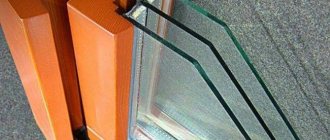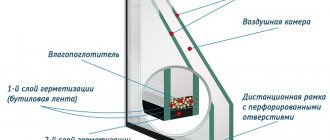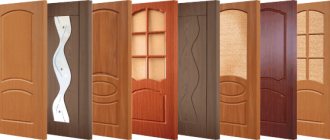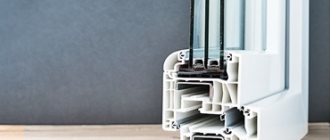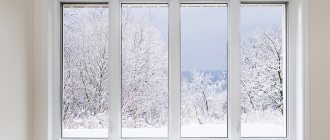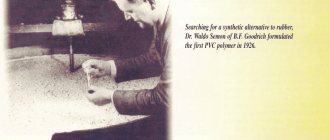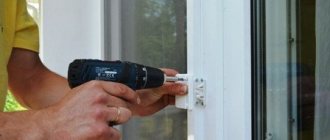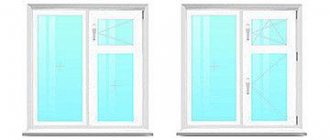A plastic window consists of many elements.
The profile is one of the most important. This is the basis of the entire structure and the frame for the double-glazed window.
The reliability of the plastic window and the comfortable environment in the room depend on the quality and characteristics of the element. Therefore, choosing a profile is a responsible matter.
Description of the concept
A window profile is a frame or a fixed part of a structure. It is installed in the window opening. The most significant characteristic of an element is its chamberness, which shows how many chambers it consists of. The ability of a window to retain heat depends on the number of chambers.
Reference. The chamber is the air space formed between the partitions of the profile. A single chamber element is a frame with one air compartment.
The spaces (compartments) are isolated from each other, which allows the temperature of each chamber to remain unchanged. A separate chamber is considered to be a compartment limited by internal ribs.
Features of PVC construction
The design of any profile is considered complex. Single-chamber has fewer compartments, only one. This can be seen in the section of the element. A small chamber filled with air allows you to retain heat .
The frame walls are made by pressing a molten mixture of polyvinyl chloride with stabilizers and modifiers. They give PVC material new qualities and characteristics.
Element components
In the inner part of the profile body there are longitudinal partitions that form air cavities - compartments. A single-chamber element has two partitions and one compartment .
Reinforcement
This is a necessary additional frame that provides the profile with additional rigidity. Reinforcement is made by a frame made of galvanized steel, resistant to mechanical stress and temperature changes.
There are three types of reinforcement:
- L-shaped - the insert is installed along two walls.
- U-shaped - three walls have been strengthened.
- Closed - the frame is located along four walls.
Important! The smaller the window size, the lighter the reinforcement can be.
Class
Its indicator is the thickness of the walls. The value of the profile width depends on the class. The higher the class, the thicker the product :
- Class A. The profile must have a thickness of outer walls of 2.8 mm, internal walls of 2.5 mm.
- Class B. The thickness of the external walls should not be less than 2.5 mm, internal from 2.0 mm.
- Class C. In this case, the thickness indicator is not standardized.
The seal is important in the profile design. The optimal number of seals is two. This will avoid condensation. For a single-chamber element, one seal is sufficient. The disadvantage of the design is the inability to retain heat inside the room at low temperatures outside.
Single or double glazing
Let's look at the main differences and in which case which one to prefer.
Any double-glazed window consists of several glasses and air layers (chambers) located between them, filled with dried air or inert gas. A single-chamber has two glasses and one chamber, a double-chamber has three glasses and two chambers of the same or different widths.
What are cameras responsible for?
The number of cameras directly affects such window quality indicators as noise protection and heat retention in winter.
It has been established that a window with a single-chamber double-glazed window is 20-30% less effective at retaining heat and silence compared to a double-glazed window. The more cameras, the higher the noise protection index and the more economical the heating devices operate in winter.
Inert gas instead of air also enhances the thermal insulation properties of the glass unit.
What types of glass are there?
The configuration of the glass also directly determines how well the window will cope with retaining heat or coolness. For example, ordinary glass with a thickness of 4 mm has minimal energy efficiency and does not protect very well from street noise. But several standard glasses of the specified thickness in a double-glazed window are already enough for serious heat retention and noise protection.
The combination of regular (4mm) and thickened (6mm) glass in one double-glazed unit also significantly improves the noise-absorbing properties of the window.
At the same time, installing special energy-saving glass in a single-chamber double-glazed window virtually eliminates the difference between it and a double-chamber double-glazed window with conventional glass.
If you install thickened or energy-saving glass in a double-glazed window, the efficiency in all of the above indicators will become even higher. True, the window will most likely increase significantly in price.
What to choose?
In order to make the right decision and not overpay for window functionality that is unnecessary in a particular case, we recommend that you rank by importance the functions that the window will need to perform.
It’s worth starting with the features of the house or apartment, the configuration and purpose of the room or other premises for which a new window is being purchased.
Single-chamber double-glazed windows are suitable:
- For glazing a balcony or loggia, if they are not attached to a room or kitchen and you do not aim to make them warm in winter.
- For a summer house, gazebo, grill house or other building that is used in the warm season and where increased thermal protection is not needed. However, if the house is located in an open area, does not have natural shade, and in the summer you are forced to use air conditioning, it is better to give preference to double-glazed windows or energy-saving glass that retains not only heat, but also coolness.
- For a house or apartment whose windows overlook the courtyard or its own plot. In such cases, enhanced sound insulation is not required. Thickened glass will cope with the minimum noise level, and energy-saving glass will help maintain the air temperature.
Double-glazed windows are suitable for:
- First of all, for cold climates with frequent and prolonged subzero temperatures. A double-chamber double-glazed window will cope with the basic task - “not to heat the street”, retaining maximum heat inside the house. If you want to save even more on expensive heating, additionally choose energy-saving glass.
- For houses and individual rooms whose windows overlook busy streets and highways. Here the importance of additional sound insulation can hardly be overestimated.
- For a room where silence is required. For example, a nursery or a bedroom.
- For “warm” glazing of individual balconies and loggias or for them combined with a room or kitchen. Since the standard heating system in apartment buildings does not affect balconies and loggias, enhanced thermal protection is required to avoid freezing during year-round use.
If you have any questions or doubts, contact our specialists for a free consultation.
Specifications
Key design parameters to pay attention to:
Width .
This is the transverse dimension of the frame or thickness. It affects the sound and heat insulation of the window. There are 3 types of profile widths - 58-60 mm, 70 mm and 80-82 mm. The classic size is 58 mm.If the assembly and installation technology is followed, the structure ensures comfortable operation of the window in any climate zone.
This indicator is used in windows with a three-chamber profile, but for a single-chamber profile it is also appropriate.
- Heat transfer coefficient . For a single-chamber element, K = 1.6 W/m2K (R = 0.62 m2K/W.
- Thickness of outer walls . This indicator affects the cost and class of the window. Single-chamber structures belong to class B. This is a budget option. If there is a task to increase the service life of the window, then you should choose a class A profile. The width of the external walls determines the indicators of reliability, service life, level of thermal protection and noise insulation.
It is also important to consider the type of glass unit that will be installed.
Recommendations for use
This element is used for glazing private houses and apartments located in the southern part of Russia . In this region, excessive efforts to retain heat are not required, and the cost of construction is much lower than windows with multi-chamber profiles.
Also, a small number of cameras is acceptable in windows installed indoors or serving a decorative function. For cold glazing of balconies and loggias, installation of stained glass windows.
Application for summer cottage
A single-chamber profile can be installed in a country house, especially if the house is not planned to be used as housing in the winter. To increase protection from the cold, it is recommended to install single-chamber double-glazed windows with energy-saving glass. In the southern regions, such a kit is also suitable for a residential building.
Important! The design and material of the profile must comply with the requirements of GOST and SanPiN 2.1.2.729-99.
single-chamber or double-chamber
State control (supervision) over compliance with technical regulations
Along with the advent of technical regulations, state control (supervision) over their compliance also appeared. According to paragraph 1 of Article 33 of the Law, state control (supervision) over compliance with the requirements of technical regulations is carried out in relation to products, production processes, operation, storage, transportation, sale and disposal solely in terms of compliance with the requirements of the relevant technical regulations.
Bodies of state control (supervision) on the basis of Article 33 of the Law are federal executive authorities, executive authorities of constituent entities of the Russian Federation, and state institutions subordinate to them authorized to conduct state control (supervision).
According to paragraph 1 of Article 34 of the Law, state control (supervision) bodies have the right to:
1) require the manufacturer (seller, person performing the functions of a foreign manufacturer) to present a declaration of conformity or a certificate of conformity confirming the product’s compliance with the requirements of technical regulations, or copies thereof, if the use of such documents is provided for by the relevant technical regulations;
2) carry out measures for state control (supervision) over compliance with the requirements of technical regulations in the manner established by the legislation of the Russian Federation;
3) issue orders to eliminate violations of the requirements of technical regulations within a period established taking into account the nature of the violation;
4) make reasoned decisions to prohibit the transfer of products, as well as to completely or partially suspend the processes of production, operation, storage, transportation, sale and disposal, if other measures cannot eliminate violations of the requirements of technical regulations;
5) suspend or terminate the declaration of conformity or certificate of conformity;
6) hold the manufacturer (performer, seller, person performing the functions of a foreign manufacturer) liable under the legislation of the Russian Federation;
7) take other measures provided for by the legislation of the Russian Federation in order to prevent harm.
Based on paragraph 2 of Article 34 of the Law, state control (supervision) bodies are obliged to:
1) during the activities of state control (supervision) over compliance with the requirements of technical regulations, carry out explanatory work on the application of the legislation of the Russian Federation on technical regulation, inform about existing technical regulations;
2) observe trade secrets and other secrets protected by law;
3) comply with the procedure for carrying out measures for state control (supervision) over compliance with the requirements of technical regulations and recording the results of such measures, established by the legislation of the Russian Federation;
4) take, based on the results of state control (supervision) measures over compliance with the requirements of technical regulations, measures to eliminate the consequences of violations of the requirements of technical regulations;
5) send information about non-compliance of products with the requirements of technical regulations in accordance with the provisions of Chapter 7 of this Federal Law;
6) exercise other powers provided for by the legislation of the Russian Federation.
Advantages and disadvantages
Despite the fact that such designs cannot be called super popular, customer reviews allow us to compile a list of their advantages and disadvantages.
pros:
Price.
A single-chamber profile is considered a very budget option. If you choose a window from a well-known manufacturer, you can get good quality at a low price.- Light weight.
- Material safety. PVC does not pose any threat to human health.
- Durability, especially with proper installation and operation.
- Tightness. Using a high-quality seal allows you to ensure a good sealing of the window.
- Convenience. The device does not require complex maintenance or restoration.
- Fire safety. Single-chamber profiles can be installed even in rooms with high temperatures.
- The design can be made in any shape and with different opening mechanisms.
Minuses:
- Number of profile cameras. This is less than the standard amount. Therefore, one compartment performs three functions: it removes condensate, contains a reinforcing liner, and serves to secure fittings. Additionally, it creates an air gap that improves the tightness of the window. This multifunctionality reduces the service life.
- Unsuitable for installation in areas with severe frosts and on large windows.
Note. The single-chamber element is excellent for residential premises as glazing of interior openings.
Reviews
This design is currently used very rarely. Therefore, there are few real buyers. According to reviews, the advantages of a single-chamber profile are:
- low cost;
- light weight;
- fire safety;
- ease of maintenance.
Minuses:
- only suitable for cold glazing;
- It is difficult to find a finished product on the market.
Single-chamber type of product can only be ordered. Reviews can be found here.
When should it be used?
The installation of metal-plastic windows with a profile consisting of five sections is relevant in hazardous areas and in regions with a cold climate, where severe frosts (20-60°) and cold north winds prevail.
Note. Durable five-chamber window systems are used for installation in homes, offices, and apartments.
It is advisable to install windows with a large number of chambers in the profile in warehouses with large window openings, where there is no heating, in order to reduce heat losses during the cold season.
window structures with five chambers in noisy areas, where there is a highway or railway nearby, or an open area where the wind constantly blows, in order to provide more comfortable indoor conditions. Also if the windows face north and cold winds prevail.
The ideal option for installing five-chamber windows would be for a large private house or cottage - this will save on heating a large area.
Such windows are also relevant in buildings where higher protection is required, since such a window is more difficult to break.
Ideal for glazing balconies and loggias , as they better protect the room from various atmospheric influences, retaining heat.
It is not advisable to install five-chamber windows in the southern regions, as well as in country and garden houses.
